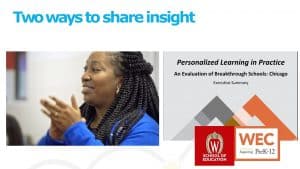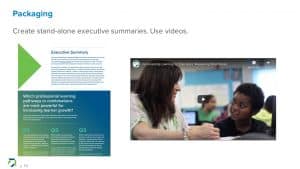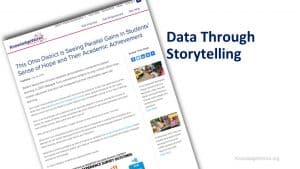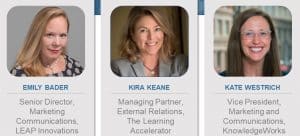Improving Communication of K-12 Personalized Learning Research
CompetencyWorks Blog
Two goals of the recent National Research Convening on Building the Evidence Base for K-12 Personalized Learning were improving communication of the evidence base and increasing its usefulness for educators and school leaders. In one session, communications professionals from three leading organizations in the field addressed the question, “What are effective strategies for communicating and disseminating findings from personalized learning research?”
The presenters were Emily Bader, Senior Director of Marketing Communications at LEAP Innovations; Kira Keane, Managing Partner of External Relations at The Learning Accelerator; and Kate Westrich, Vice President of Marketing and Communications at KnowledgeWorks. They each offered valuable advice and compelling examples from their organizations’ work.
Communication Strategies from LEAP Innovations
LEAP Innovations works with 140 schools in Chicago “to catalyze innovation to help transform how students learn through personalized learning experiences.” Emily Bader laid out four purposes of LEAP’s communications work:
- Show the progress of our work.
- Educate and inform by answering: “What does personalized learning look like?”
- Uncover and address opportunities and needs.
- Engage constituents and garner support.
When she arrived at LEAP two years ago, after many years as a brand manager for large companies, she felt that LEAP’s data and reports needed to be complemented by stories with “human touch.” To accomplish this, the organization developed “impact stories” that had the traditional arc of the “hero’s journey”—an arduous challenge to overcome, a journey to address the challenge, and a victorious result. Bader noted that the impact stories are not a replacement for rigorous quantitative research, but they “add that level of heart that really connects with people and connects them to the power of the work.”

One story featured a student whose school’s personalized learning model helped him “manage through his trauma” and become a leader. A second story illuminated a teacher using LEAP’s model to connect with students more deeply, with benefits for everyone involved. A third story focused on a school’s successful redesign and transformation process. Bader demonstrated the power of video storytelling with a three-minute film LEAP created about this school, featuring live classroom footage, earnest and engaged students, proud parents and teachers, and soaring music, interspersed with statistics about students’ academic growth and higher student enrollment and teacher retention. (You can watch it starting eight minutes into the session video.)
Communication Strategies from The Learning Accelerator
The Learning Accelerator (TLA) aims to serve as a “learning engine for the education field” by “identifying patterns and sparking movement on shared problems of practice.” Kira Keane’s presentation described TLA’s work with the Lindsay Unified School District, an early adopter and deep implementer of competency-based education. Lindsay was aiming to create a personalized approach to professional learning for their educators, and TLA was helping the district assess which professional learning strategies were most effective in improving student experiences and outcomes. The products of this work were intended to help not only Lindsay staff but also the larger field of personalized learning.
Keane’s central lesson about communicating the evidence base was that we need to make it accessible to everyone who needs it. Some of TLA’s products were lengthy research reports, but they also created several other resources for diverse audiences. Within the research papers, they included various elements such as call-out boxes to convey information at a glance. To make the reports “more skimmable,” they also developed “crisp, graphical” executive summaries, which they also published as brief, stand-alone versions.

A series of videos they developed, each just two to three minutes long, were particularly helpful for making the findings “as modular as possible,” capturing teacher and student voices, and sharing the findings with educators and the media. Social media was an effective way to share “human connection” aspects, such as quotations from teachers, as well as quantitative findings through tables and infographics. TLA also created a single landing page on their website for all of the products from the project. This made everything easy to find, allowed TLA to offer framing and context, and enabled Lindsay to mirror the content on their own website.

Keane also emphasized the importance of making all content accessible online for use with assistive technologies, following the protocols of the Web Accessibility Initiative. All of TLA’s images have “alt text,” and they provide versions with enhanced accessibility features. Finally, they share all of their products under a Creative Commons license that makes the content free to use, share, and even modify with attribution.
Communication Strategies from KnowledgeWorks
KnowledgeWorks relies on “evidence-based practices and a commitment to equitable outcomes” in order to “partner with learning communities to create purposeful paths and places to ensure each student graduates ready for what’s next.” Kate Westrich emphasized telling stories with data and illuminating data through stories to reach diverse audiences.
Her presentation focused on the Marysville, Ohio school district, which had adopted personalized, competency-based education. They wanted to share their findings from a survey that tracks belonging, hopefulness, engagement, and ability to self-manage. Westrich said these concepts are important but “fuzzy,” which made sharing the data tricky and challenging but also fun. Her team used many “alternate tellings of the same story.”

The district had relied on number-dense bar charts that not all stakeholders could readily interpret, so KnowledgeWorks worked with a graphic designer to develop simpler infographics. Westrich noted a trade-off here—that important information was lost when translating to the simpler presentation. Communicating evidence to diverse stakeholders requires navigating these trade-offs and recognizing that each strategy has its strengths and challenges.

Pictures are an even more basic form of evidence, but one that resonates with many audiences. For example, the Marysville students faced many serious life challenges, but photos from the project show them happy, engaged, and supporting each other. Images alone are not enough evidence to justify scaling an intervention, but perhaps it’s also true that no intervention should be scaled without them.
Similarly, Westrich mentions their “Data with Drake” blog post series, which is very popular with readers due to presenting findings in a casual, approachable way. She said, “I think a lot of times I get caught up in … making sure I have [made] all the different points, and [Drake Bryan’s] posts have just been plain English—like ‘This is how just how it works!’—and it resonates with people quite a bit.” Her point seemed to be that for certain audiences, communications about the evidence base for personalized learning can miss the forest for the trees.
Conclusions and Reflections
As a light-hearted aside in her presentation, Bader added, “Full disclosure: As we focus on these impact stories, we’re really focusing on our success stories and our exemplars.” Hearing about these exemplars is essential for helping key audiences understand best practices in personalized learning. Acknowledging stumbles, course corrections, and unexpected findings is also important for professional learning, evaluating our work critically, and continuous improvement to maximize desired student outcomes.
It was so valuable to hear from these three seasoned communications professionals from organizations in our field. Their presentations suggested that achieving a widespread shift to personalized learning will require an evidence base with diverse forms of evidence and a range of communications strategies. Different stakeholders typically find different forms of evidence most compelling or most useful, so we need inspiring stories and images in addition to findings from rigorous quantitative studies.

Learn More:
- National Research Convening on Building the Evidence Base for K-12 Personalized Learning: Overview and Session Materials
- How Will Your Research Narrate Our History?
- Strong Evidence of Competency-Based Education’s Effectiveness from Lindsay Unified School District
Eliot Levine is the Aurora Institute’s Research Director and leads CompetencyWorks.